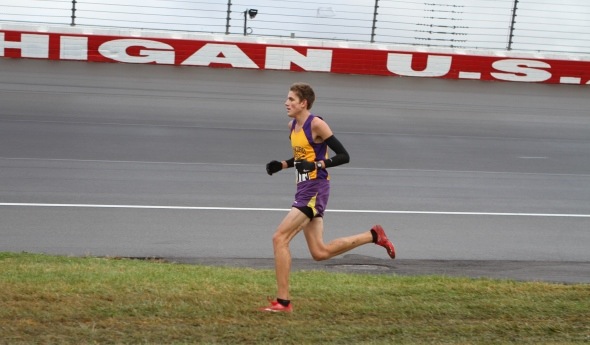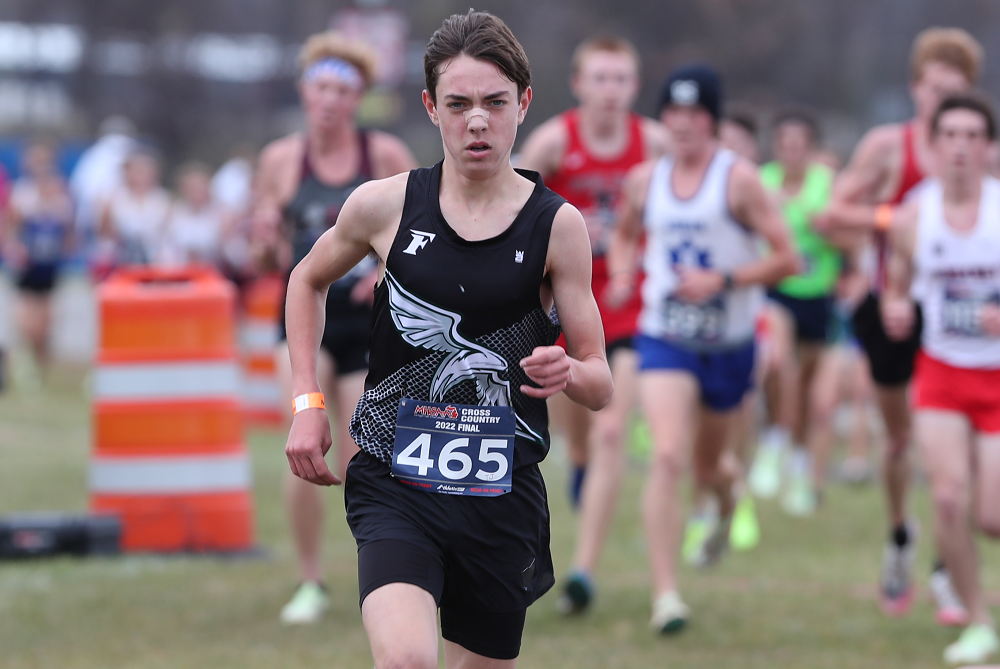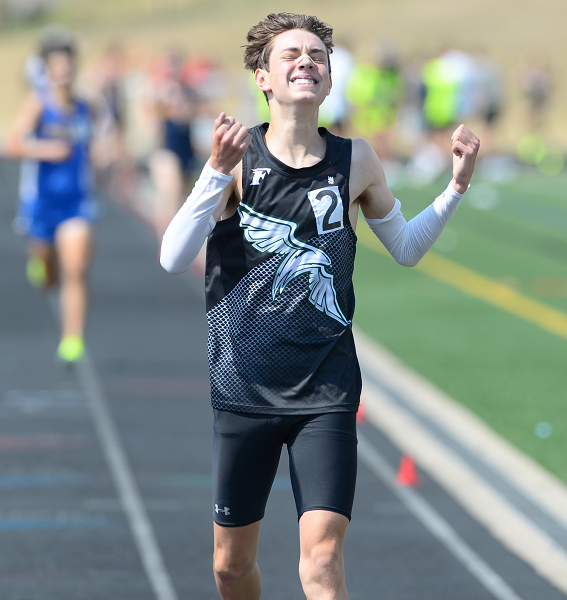
Saugatuck Wins Despite Concord Repeat
November 2, 2013
By Bill Khan
Special to Second Half
BROOKLYN — Jesse Hersha had just crossed the finish line with his second MHSAA Lower Peninsula Division 4 cross country championship, but he wasn't thinking about himself.
As soon as the Concord junior finished the 3.1-mile course Saturday at Michigan International Speedway, he turned around and watched the race unfold behind him.
Of particular interest were the purple and gold jerseys of his Concord teammates, who were engaged in personal battles that would determine whether or not the Yellowjackets would win a third straight team championship.
Trying to do the math with so many bodies sprinting to the line proved to be too difficult, as did the challenge of securing a three-peat. Concord had to settle for a third-place finish with 134 points, marking the sixth straight year it finished in the top six.
"I wasn't focused on my race so much as I was focused on my team's race," Hersha said. "We didn't do as well as we would've hoped, but it happens."
It was pretty much a foregone conclusion that Hersha would win a second straight championship, but stranger things have happened at MIS. He dominated the field as expected, posting a time of 15:49.2 on a muddy course to win by a whopping 44.8 seconds over East Jordan senior Josh Wojan.
"It felt a lot different, because this year you knew as well as I did that I had a really good chance of winning it," Hersha said. "I'd beaten almost everyone there except (Evart's David) Zinger last year, but I still had that doubt. This year, I didn't have that doubt at all."
Hersha took off hard and didn't give anyone a chance to get into the race. Pushing himself when nobody else was around to assist was the most difficult part for Hersha.
"It's tough, but you've got to think to yourself, 'I've got to get going,'" he said. "I could jog the last 100 meters and maybe still win, but you've got to keep pushing yourself, even if no one else is pushing you."
For someone accustomed to winning easily, Hersha said his most memorable race this season was the only one he didn't win. He ran with the larger schools at the Spartan Invitational (at Michigan State University) on Sept. 13, taking third in a personal-best 15:31. He won his other 13 races this year.
"That was fun," he said. "By the time I got to the second mile, guys were catching up with me and passing me. It was a lot different."
Dethroning Concord as Division 4 champion was Saugatuck, which scored 113 points to edge Mount Pleasant Sacred Heart by eight.
The difference, as it often does, came down to the fifth and final scoring runner. Saugatuck junior Joe Brown was 40th among team runners in 17:52.2, 17 places ahead of Sacred Heart sophomore Sam Neyer (18:07.4).
Junior Jacob Pettinga led Saugatuck, placing third overall in 16:36.9. Senior Clayton Springer was seventh among team runners (16:53.7), freshman Nick Butch was third (17:27.0) and freshman Zachary Pettinga was 38th (17:48.1).
Only three Saugatuck runners had ever competed in the MHSAA meet, with three freshmen in the varsity seven. The team's best finishes ever were fourth-place showings in 2006, 2007 and 2012. Saugatuck had never qualified for the MHSAA Finals until 2001, but has now made it eight of the last 13 years.
PHOTO: Concord's Jesse Hersha extends his lead on the way to his second straight MHSAA championship. (Click to see more from RunMichigan.com.)

Freeland's Hansen Not Focused on Joining All-Time Greats - But On His Way
By
Paul Costanzo
Special for MHSAA.com
September 29, 2023
The goal written on Matt Kaczor’s Post-It Note was sub-15 minutes, 15 seconds. That’s what the Freeland cross country coach was hoping for from star runner TJ Hansen during his junior season.
 Kaczor tore it up after seeing Hansen run a single race this fall.
Kaczor tore it up after seeing Hansen run a single race this fall.
“Knowing what he did over the summer and where he was at, seeing what his 1,600 (meter) and his mile got down to, I had a feeling he could get under 15:30 quickly,” Kaczor said. “After the first race, I looked at my assistant and was like, ‘I’ve gotta rip up that Post-It Note. I don’t think our goal is on the level of where he’s at right now.’ At first, it was break 15:15. Once I saw him race at the Under the Lights (on Aug. 18 at St. Johns), I was like, ‘Yeah, he’s going sub 15.’”
Hansen ran 15:39.6 in that first race, and on Sept. 7, in Shepherd, he ran 15:13.9 to meet the goal written on the now-shredded Post-It Note.
This past Saturday, he ran 15:03.7 at the Cadillac Veterans Serving Veterans Invitational. It’s the fastest time recorded in Michigan this year, and a signal that Kaczor might be filling out a new Post-It Note before the season is out.
“The sub-15 barrier, that’s been something on my mind for a while,” Hansen said. “Now that I’m edging closer and closer to that, it’s been exciting. With how heavy my training has been, I wouldn’t expect (to have run this fast this early). Being able to run the times I am really paints the picture for what’s ahead.”
Hansen came into the season already regarded as one of the elite distance runners in the state. He won the 3,200 meters at the MHSAA Lower Peninsula Division 2 Track & Field Finals this past spring. He’s also finished all-state (12th and fifth, respectively) the past two seasons at the LPD2 Cross Country Finals.
His current trajectory, however, would put his name near some of the state’s all-time greats. But that’s not something Hansen is focusing on.
“I really don’t like to compare myself to others,” he said. “I don’t focus on that. I try to be the best TJ Hansen that I can be. The best version of myself.”
Focusing on himself is almost necessary for Hansen, as he’s spending a lot of time during his races running by himself.
At each of the big events Freeland has run in this season, Hansen has finished at least 20 seconds ahead of his nearest competitor. That includes all divisions of the Duane Raffin Festival of Races in Holly.
In Cadillac, where Hansen ran his current best time, he was a full minute ahead of the rest of the field.
 “He’s just a special athlete,” Kaczor said. “I can’t see Freeland having someone like this in a while. He’s a generational talent. What’s crazy is, I had the school record when he was a freshman. He and Braden (Honsinger) broke it last year. But TJ has now dropped that school record (set in 1998) by almost a minute.”
“He’s just a special athlete,” Kaczor said. “I can’t see Freeland having someone like this in a while. He’s a generational talent. What’s crazy is, I had the school record when he was a freshman. He and Braden (Honsinger) broke it last year. But TJ has now dropped that school record (set in 1998) by almost a minute.”
Hansen’s achievements have already put him on a path to run at the next level, which is something of a family tradition.
His older sisters Peyton and Kiera are track & field athletes at Wayne State and Eastern Michigan, respectively. Their parents, Tim and Pam, were track & field stars at Central Michigan.
TJ has drawn the attention of coaches around the country, including from Michigan, Michigan State, Wisconsin, Tennessee and Colorado.
Having family members who know the process is a help for Hansen, and he said they’ve all been good about allowing him to choose his own path, whatever that may be.
“He’s from a good family that knows how to work and knows how to get things done,” Kaczor said. “He knows that if he puts in the work, he’s going to be at a good spot.”
While Hansen admits it can be a bit overwhelming, he’s using it as motivation to run faster and continue to put his name out there.
Also serving as motivation is 2022 Division 2 champion Connell Alford of Chelsea. Alford is among the elite group of runners in Michigan who have broken the 15-minute mark, doing it twice a year ago.
He currently has the state’s second-best time behind Hansen’s this year, running 15:09.1 at the MSU Invitational on Sept. 15.
“Whenever I see him drop a time, my main goal is to run faster,” Hansen said. “Whenever I see him run a good time, that motivates me to work hard.”
The two won’t see each other until the MHSAA Finals on Nov. 4 at Michigan International Speedway. It’s an opportunity Hansen is excited for, as it’s a chance to race and be pushed toward the lofty goals he’s set for himself. Kaczor is excited about it, too, even if it might mean having to replenish his supply of Post-Its.
“We don’t talk about winning the state title; we talk about making sure that we have great races on those days,” Kaczor said. “We can’t control how somebody else runs. It’s a matter of can we, if the weather is right and the course is in good condition, can we be one of the few guys that has run in the 14s on that course? That’s the goal. Put yourself in some great categories with those upper echelons and the greats of all-time.”
 Paul Costanzo served as a sportswriter at The Port Huron Times Herald from 2006-15, including three years as lead sportswriter, and prior to that as sports editor at the Hillsdale Daily News from 2005-06. He can be reached at [email protected] with story ideas for Genesee, Lapeer, St. Clair, Sanilac, Huron, Tuscola, Saginaw, Bay, Arenac, Midland and Gladwin counties.
Paul Costanzo served as a sportswriter at The Port Huron Times Herald from 2006-15, including three years as lead sportswriter, and prior to that as sports editor at the Hillsdale Daily News from 2005-06. He can be reached at [email protected] with story ideas for Genesee, Lapeer, St. Clair, Sanilac, Huron, Tuscola, Saginaw, Bay, Arenac, Midland and Gladwin counties.
PHOTOS (Top) Freeland's TJ Hansen leads a pack during last season's LPD2 Final at Michigan International Speedway. (Middle) Hansen enjoys a moment of exhilaration after winning the 3,200 this spring at the LPD2 Finals at Ada Forest Hills Eastern. (Top photo by Carter Sherline/Run Michigan; middle photo by Dave McCauley/Run Michigan.)

